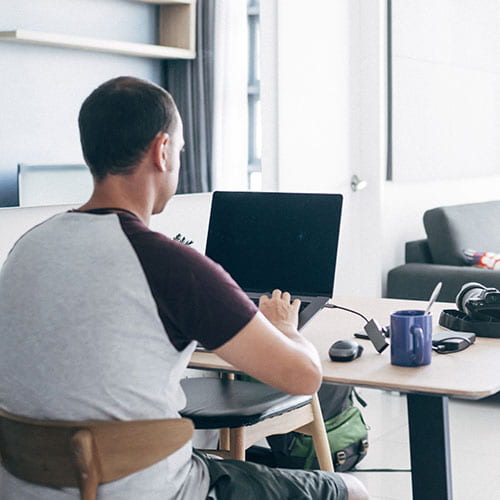By Faiad Alam
2020 Wade Rakes EMERGE Intern, Center for Health and Biosciences
The COVID-19 pandemic has drastically changed how society functions, and the transformation of America’s school system is a prime example. In 2020, in-person, interactive classrooms converted to virtual learning environments from Pre-K to the college level. Schools and university campuses shut down nationwide to curb transmission of the SARS-CoV-2 virus and turned to virtual platforms such as Zoom and Google Classroom, forcing students to continue advancing their education from home. Although a home classroom environment may seem comforting to some, for others it is not. A central issue arises from the inequitable access to educational resources from home, especially for students from low-income households. For many of these students, schools are actually a safe haven from unstable home environments and circumstances such as homelessness and poverty. Many households also do not have access to high-speed internet. Due to these factors, there is a growing educational gap between students from high- and low-income households. School administrators from the elementary to the college level must address these disparities to resolve America’s deepening education crisis.
Just like there is an evident socioeconomic gap in America, the same disparity can be seen in school systems: Wealthier neighborhoods support well-funded schools, while the opposite occurs in low-income communities. At the college level, access to equitable educational resources for first-generation low-income (FGLI) students is often complicated by trying to balance additional responsibilities at home while pursuing a college education. And in basic education, a 2015 federal report during the Obama administration showed that the gap in funding between “rich” and “poor” schools increased by 44% over the past decade. A 2019 follow-up report by the Trump administration suggests the gap continued to widen during the 2015 to 2016 school year. With the onset of the pandemic, the inequities have only been exacerbated. Students in wealthier communities have been able to receive more support from well-funded school districts compared to students in financially-restricted school districts. In addition, as schools start to reopen, well-funded schools have had greater capacity and capability to implement the infrastructural and logistical measures needed to bring back more students safely, further widening the achievement gap. Meanwhile, students in underserved communities disproportionately suffer from financial instability, increased household responsibilities, lack of learning infrastructure and mental health problems, to name a few.
As the COVID-19 pandemic progresses and new pandemics potentially lurk on the horizon, if we are to create an equitable learning environment at home for all students, more individualized attention must be paid to students at home to help meet their needs. As a case in point, during the COVID-19 pandemic, thousands of students in Houston lacked access to an internet connection or a proper computer to do schoolwork. Despite the growing impact on basic education of this “digital divide,” the state legislature failed to allocate proper federal education funds to address the problem. Local initiatives have been more successful. For example, by August 2020, Harris County approved the Digital Access Program and Project 10 Million, which partnered with T-Mobile to distribute thousands of hotspots and laptops to underserved students across Houston. This combination of prioritization of student’s needs, allocation of scarce resources and public-private partnerships between local government and businesses might be a viable solution. However, such policies should include state and federal initiatives that are open to all students in need rather than being district-specific. This approach would also help mitigate other issues driving disparities in education, similar to how providing free student lunches has done so. Free mental health counseling and rent relief for parents would also assist students in need beyond those periods where home learning is required.
Today, the COVID-19 pandemic is still ongoing, and many communities continue to see no sign of a return to “normal” for schools. In my case, as a sophomore undergraduate at Yale with an interest in biomedicine, I can expect courses — and lab work — for the fall 2021 semester to take place mostly online. As the Wade Rakes EMERGE intern at the Baker Institute for Public Policy, I have had the opportunity to reflect on how off-campus learning can become a place of inequity for FGLI students as they frequently face greater challenges to learning from home than students from better-off families. What I have learned from this pandemic is that access to education is as unequal as ever, and the pandemic has enhanced the decades-long problem of minorities and individuals from underserved communities being underrepresented in science, technology, engineering and math (STEM) fields. Underserved students face greater challenges at home, and some may not be able to return to school as soon as their better-off peers. Although it is improbable to recreate the school environment at home, there are opportunities to implement policies that can extend school services to those who are in need. Without proactive policies, virtual learning is one more hurdle to attaining equitable access to education for low-income students.
This blog post is part of the Baker Institute Science and Technology Policy Program’s “What I learned in 2020” series. The author is an undergraduate student at Yale University and the 2020 Wade Rakes EMERGE intern at the Baker Institute’s Center for Health and Biosciences.
